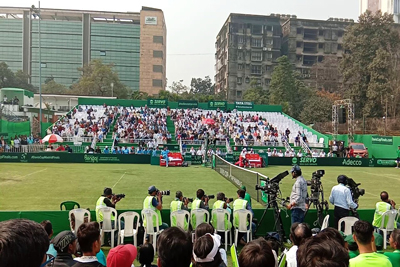
The Calcutta South Club, situated on Woodburn Park Road, beside the Woodburn Park, was founded without a name in June 1920 with the handsome amount of Rs.35 collected from five members. It owes its origin to a strange incident. One evening, while the two friends, Anadi Mukherjee and Ganesh Dey were cycling along Woodburn Road, they saw a large gathering inside the Woodburn Park and came to know that Punjab Club, a tennis club, was entertaining a delegate from Punjab who had come to participate in the Indian National Congress.
The friends became interested about the activities of the club and requested the secretary for their membership. However, their request was turned down then and there, as the club was restricted to the people belonging to other communities. The friends felt insulted and approached Mr Chapman, the District Engineer of Calcutta Corporation, to grant a lease for one tennis court in the same park for use of all communities. The Calcutta South Club was born in 1920, as the friends could convince Mr Chapman.

Prior to 1920, tennis was confined to the privileged society and the Calcutta North Club, located at Beadon Square was then the home of the Indian tennis. Nevertheless, second hand gear was bought for the newly founded nameless club and the spirited members plays started to play the game without the screens. Finally, the nameless club was named as Calcutta South Club, at the suggestion of Ananto Mookerjee, one of the members. Within a short time, Mr R Daglish was named as the first President of the club, while Anadi Mookerjee was entrusted with the responsibility of the secretary.

At the end of the first year, the club had 17 members, including famous Japanese Shimdzu and Okamato who previously used to play on the lawn of Nippon Club. Shimdzu did not like to play with old balls, though he never cleared the payments of club bills on time. However, due to tight financial condition, the club was not in a position to afford new balls more than twice in a month. Finally, it was decided that Shimdzu would bring a dozen new balls with him whenever he would visit the club to play and after the end of the play, he would leave the balls for the club.

The Calcutta South Club, that started its journey with a single grass court, progressed steadily with the passing of time. Four more courts were sanctioned in 1924 and five more in 1925. With financial assistance of Sajjan Chowdhury, a member of the club, a clubhouse and the pavilion was built and opened on 4 November 1926. With the active help of the then Mayor of Calcutta Corporation, Mr JM Sengupta, who was also the vice-president of the club from 1926-1933, six more courts were sanctioned in the same year.
However, there was a vigorous press campaign against the creation of new courts involved uprooting of several big palm trees, which was termed as the vandalism in the Park. However, despite the protests, the club won the battle. Later, for yearlong continuous play, six hard courts were built, which were inaugurated on10 June 1934. During the same year, the existing pavilion was also extended, along with the bar facilities. Much later, to meet the need of the day, four clay courts were lighted in 1985 and two asphalt based rubberized lighted hard courts with latest technology were added in 2004.


Today, equipped with six grass, six red clay and five hard synthetic courts, the Calcutta South Club is one of the few clubs in India to boast of having all the three playing surfaces at one place. In order to limit the liability of its members and to secure additional benefits, the club was turned into a limited company in 1959, where the members are its shareholders.
The club is known as the cradle of lawn tennis in the country, as it nurtured many talented buds from the Dilip Bose to Naresh Kumar, Jaidip Mukherjee, Premjit Lal, Akhtar Ali, Zeeshan Ali, Leander Paes and many others, all of whom represented India in the prestigious Davis Cup.
